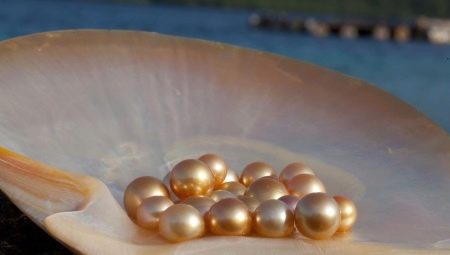Jewelry made of pearls is quite popular among women and girls of any age. However, not all representatives of the fair sex know that in nature there are different types of this stone: river and sea. What are the features of river pearls, how is it formed, how does the marine variety differ from the river one, what subspecies of river pearl do exist? You will find answers to these and many other questions in our article.
What it is?
River (freshwater) pearls are a pearl gem, which has a small size. These beads are completely natural, since people do not participate in their creation (however, to date, special pearl farms have already been created). Pearl beads form inside the mollusk shells.
Noteworthy is the fact that mollusks grow a precious and beloved stone by many from simple sand grains. In one sink several pearls can be at once.
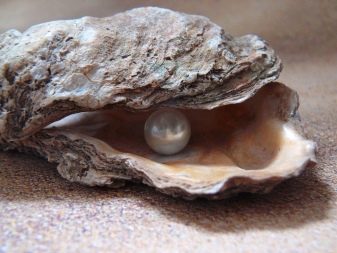
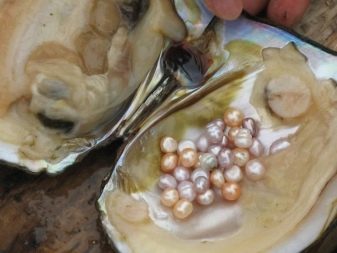
In nature, it is quite difficult to find several identical pearls, because each of them is unique in its external properties. The color, shape, and some other characteristics of the pearls are completely dependent on the particular mollusk in the shell of which they were grown. That is why stones can be found on sale that have perfect shapes and proportions, but specimens that are not very attractive from an aesthetic point of view can also be found.

How is it formed and where is it mined?
Pearl beads are formed inside the mollusk shell due to the ingress of grains of sand. Due to the fact that in the body of the aquatic inhabitant there is a huge number of nerve endings, he immediately senses a foreign body, so the response should be immediate. As a protective reaction to the ingress of a foreign element into the shell, the oyster secretes nacre, with which a grain of sand grows. The period of formation of the gemstone is from 3 to 12 years. This period may depend on a large number of factors: the age and type of the mollusk, the state of the environment, and much more.
In cases where the pearls are grown on their own, the alien element is specially placed in the oyster shell. As for the extraction of pearl beads, it is carried out in several countries: in Russia, the United States of America, Germany, China.
To get pearls, it is necessary to collect mollusks and open their shells.
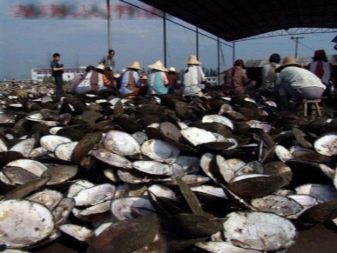
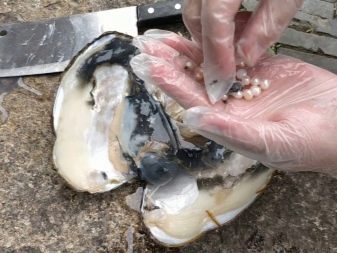
Varieties
In nature, there are only 2 varieties of river pearls. They differ in the method of cultivation.
- The first species is formed randomly, without human intervention. There are huge difficulties regarding the extraction of such a stone. Firstly, it is quite difficult to detect, because the only indirect sign of the presence of pearls is a large accumulation of freshwater oysters. In addition, it should be noted that the extraction of such precious stones is associated with large material and time costs.
- The second kind of river pearl is cultured beads. These are precisely the stones that are cultivated by people artificially, and are presented in large numbers on the jewelry market today.
In addition, pearls can be divided into categories depending on the color in which the beads are painted: white, cream, pinkish, etc.
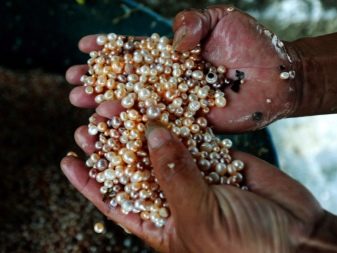

What is the difference from sea pearls?
As mentioned above, in nature there are 2 varieties of pearls: sea and river. Both of these stones are highly valued by jewelers and are used to make a variety of jewelry. Despite a large number of identical characteristics, sea and river pearls also have pronounced differences. Let's get acquainted with them in more detail.
- First of all, it should be said about the brightness of pearls. Marine specimens shine much better and brighter. Against the background of marine representatives, river stones lose - they look more dull.
- The shape of sea and river pearls is also different. Of course, there are exceptions, however, mostly freshwater specimens have a more elongated, oval shape, and sea stones, on the contrary, are rounded.
- The color characteristics of 2 varieties of beads are also significantly different. The range of shades of river pearls is quite limited and varies from white to milky shades. At the same time, unusual pearls can be found in the deep sea that can be colored in the brightest shades (for example, black or pink).
- However, there are also indicators by which sea pearls significantly lose to river pearls. These characteristics include, above all, durability. So, over time, those stones that were found in seawater can lose their luster and luster. River specimens retain the attractiveness of their appearance for much longer. This difference is explained by the different thickness of the pearlescent layer on the stones.
- In addition, one cannot but note the differencethat in the shell of one river mollusk you can find from 10 or more pearls, and in the shell of the sea - only 1.
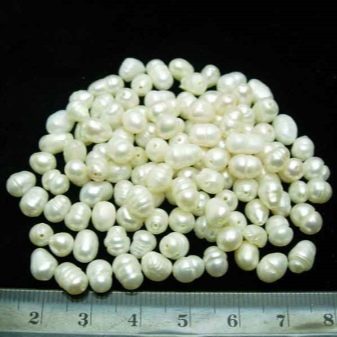
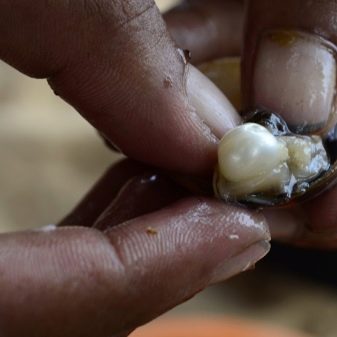
Based on all the above characteristics, it is quite simple to conclude that river pearls are cheaper than sea pearls. That is why many of the fair sex prefer this stone.
Classic pearl beads look equally attractive, regardless of what kind of pearls they are made of, but the price of a river stone will be much lower.
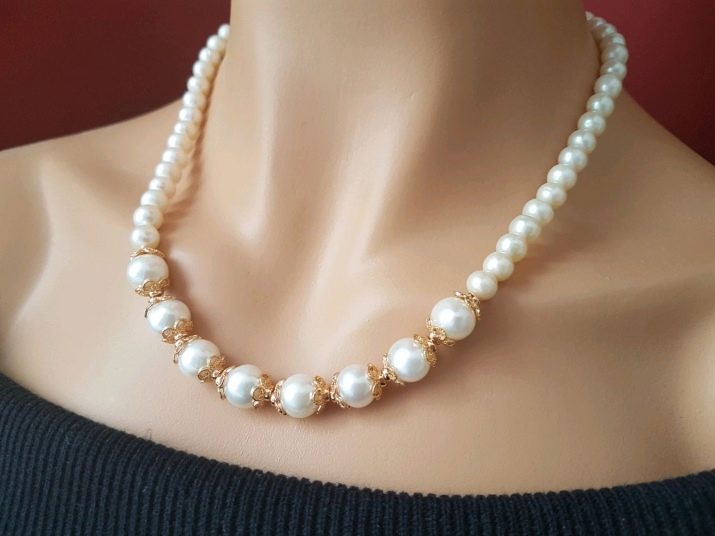
How to distinguish from a fake?
Due to the fact that pearl jewelry is quite popular in the jewelry market, many fraudsters and unscrupulous sellers try to give out other, cheaper materials for pearls. To distinguish a natural stone from a non-real one, you need to be guided by a few simple rules.
- First of all, it should be remembered that no matter how high-quality the fake is, in any case it will weigh less than natural stone. Therefore, if in front of you are several identical in appearance, but different in mass of decorations, then give preference to a heavier version.
- Natural pearl is a stone that is always cool to the touch. If the seller suggested that you familiarize yourself with the jewelry closer and touch it, note that the stones that will be warm are not real.
- Natural stone has special mechanical and physical properties, which are primarily associated with its internal structure. So, if two natural pearls are rubbed against each other, then no traces or scratches will appear on them. In addition, if you throw the pearl on a hard surface, then it must necessarily bounce off of it.
- Also, when buying, carefully inspect the appearance of the stone. It must be intact and have a homogeneous structure. If bumps in color or scuffs are noticeable, then they offer you a fake, so it is better to refuse any transactions with such a seller.
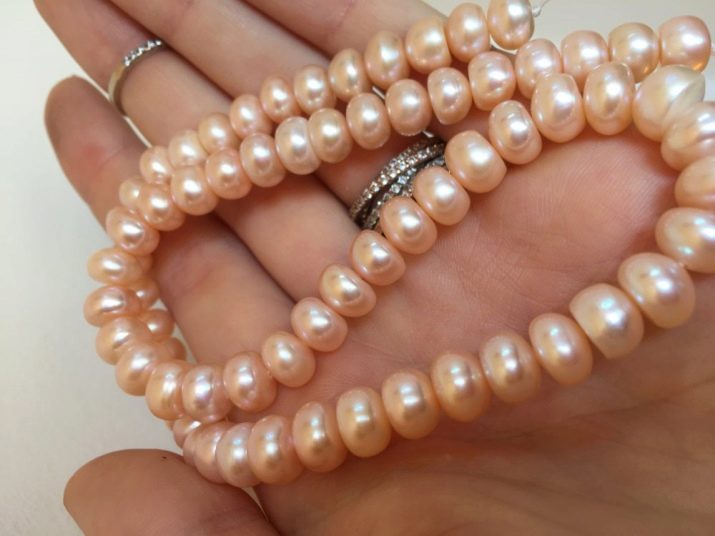
Application
River pearls are widely used in various areas of human life. First of all, this stone is used in jewelry that can be worn by all the fair sex, regardless of age, body type, etc. It is believed that a thin string of pearls is able to give the image a nobility and status.
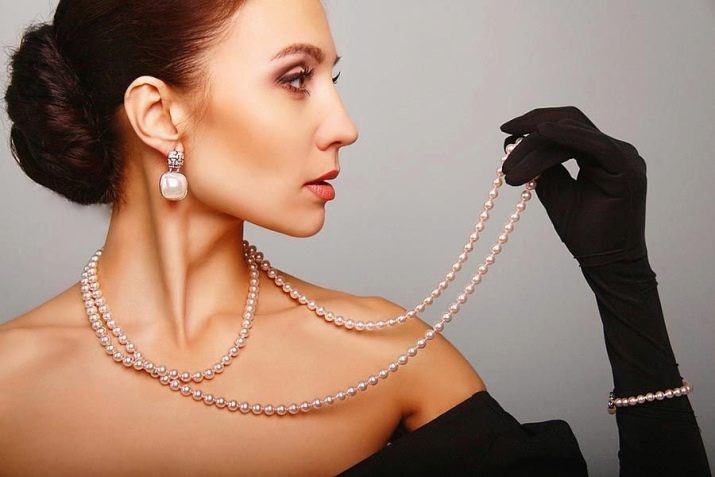
In addition, it is believed that pearls have a large list of magical and healing properties. In this regard, various amulets and talismans are often made of stone, which have healing and magical properties. Many psychics and people with supernatural abilities use pearls in their rituals.
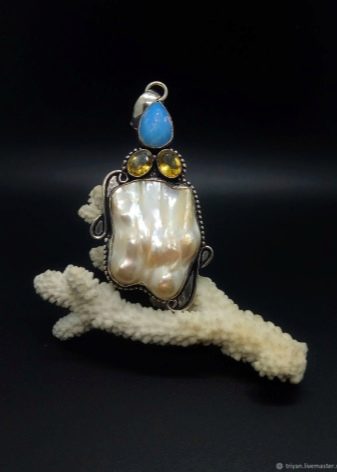
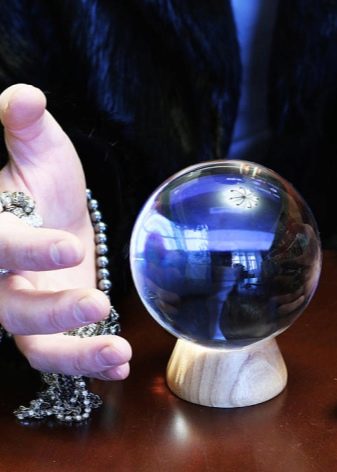
Storage and care
In order to extend the life of the pearl and maintain an attractive appearance of the stone for a long time, it is necessary to observe simple rules for it storage and care of him.
- First of all, it is important to pay attention to the storage conditions of pearl jewelry (especially if you do not use them every day). Experts recommend storing river stone in a separate box or box. Thus, the stone will be in the dark and, as a result, will be protected from a large number of external negative influences. However, one casket is not enough. Before placing a pearl jewelry in any container, it must be carefully packed in a fabric bag (it can be made of linen, silk or satin).
- In addition, in order to maintain the brilliance of natural gemstone, it is necessary to take care of its timely cleaning. In no case, during such a procedure, you can not use chemical components or aggressive detergent solutions, as they can only harm the decoration. An ideal solution for cleaning pearls from dust and dirt is soap.
Wipe the beads with a soft, delicate cloth. Thus, to clean a pearl jewelry at home is quite simple.
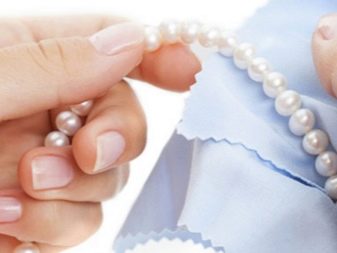
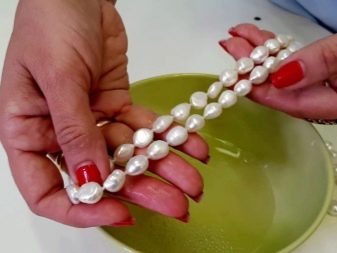
About the history and origin of pearls see below.
